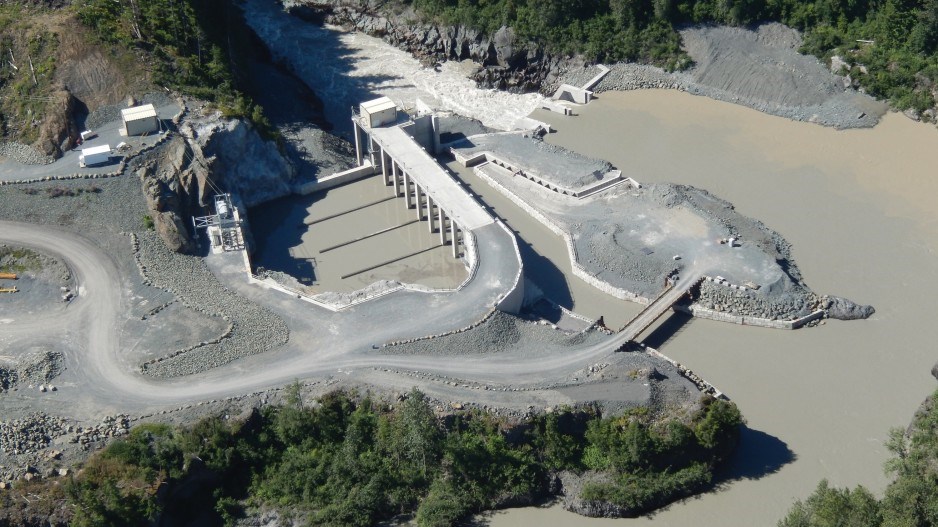By the time the $9 billion Site C hydroelectric dam comes online in 2024, more than half the power it produces could be spoken for by just three liquefied natural gas (LNG) projects, if they’re built.
But given recent setbacks in the global LNG industry, that’s starting to look like a big “if.” If the projects don’t go ahead, the province could be stuck with a surplus of power, although long-term, the utility insists the power will be needed to address general population and economic growth.
In the short-term, however, BC Hydro has a plan for cutting costs and supply that includes a scenario in which up to one-quarter of the province’s small independent power producers (IPPs) are simply shut down.
BC Hydro is currently facing a $3.5 billion revenue shortfall, due to a drop in power demand from heavy industry – mines, pulp and paper mills and the gas sector.
The utility is also paying more for power from IPPs than it had projected it would, according to its three-year revenue requirements application to the BC Utilities Commission (BCUC).
In fiscal 2015-16, BC Hydro ended up paying $238 million more than it had budgeted for “non-heritage” power (power from the private sector). And it projects that it will pay $210 million more for that power in 2019 than in 2016.
Fourteen contracts with IPPs expire at the end of 2019, and BC Hydro plans to negotiate lower rates to reflect lower costs of renewable energy. The Crown corporation plans to renew only 75% of the agreements.
“That must mean that 25% fall off the table,” said Paul Kariya, executive director for Clean Energy BC, which represents the IPP sector. “My members are saying to me, ‘Paul, in a monopoly situation, we have nowhere else to go.’ If BC Hydro says, ‘we’re not buying your power, for a whole host of reasons,’ we’ll have to terminate and we’ll have to shut down because we can’t sell to anybody else.”
Even worse for the IPP sector in B.C. is that BC Hydro also plans to review the rates it offers to IPPs under its standing offer program (SOP), in which Hydro agrees to long-term power purchase contracts on projects of 15 megawatts or less.
“I think there’s some real high feelings amongst those in the SOP group, with these unilateral cuts that BC Hydro’s made,” Kariya said. “They’re very angry.”
But others, including the NDP, think it’s high time BC Hydro ratepayers stopped having to pay a premium for “boutique” power from the private sector.
“They bought a bunch of IPP power they didn’t need,” said Adrian Dix, the NDP’s BC Hydro critic.
But David Austin, a lawyer specializing in energy for Clark Wilson LLP, points out that the contracts that are up for renegotiation aren’t the ones that were built under the current Liberal government as a result of a 2008 independent power call. They were built in the 1990s, under the Social Credit and NDP governments.
About 24% of the power used in B.C. comes from private sources. But only about 14% comes from what Kariya calls “true” IPPs –companies whose sole business is producing power. The rest is power sold to BC Hydro from industry. Rio Tinto Alcan, for example, produces its own hydropower for its aluminum smelter in Kitimat and has an agreement with BC Hydro to sell surplus electricity.
BC Hydro also classifies the power it gets from the Waneta hydroelectric dam, which is owned by Teck Resources (TSX:TCK.B), as independent power, even though BC Hydro owns one-third of the dam, for which it paid more than $800 million in 2009.
But BC Hydro’s documents are misleading, because they make no distinction between true IPPs (those whose sole business is producing power) and industrial sources, like the Waneta dam, the Rio Tinto Alcan dam and the forestry sector.
Austin said BC Hydro’s documents suggest that the unexpected spike in power that BC Hydro was obliged to buy in fiscal 2015-16 didn’t come from the IPP sector, but from industries like Rio Tinto Alcan. BC Hydro confirmed that power sales from Rio Tinto were $130 million higher than forecast.
As for its long-term load forecast, BC Hydro is now including potential demand from the LNG industry. It’s the first time BC hydro has put firm numbers to power demand from LNG in its long-term load forecast.
It calculates three LNG projects – FortisBC’s Tilbury Island, the Woodfire LNG plant in Squamish and Shell’s large LNG Canada project in Kitimat – will require 2,662 gigawatt hours per (GWh) year. That is more than half what the Site C dam would produce (5,100 GWh per year).
They are the only projects included in the forecast because they are the only ones with energy agreements with BC Hydro. Other projects would burn natural gas for most of their energy needs.
Woodfibre LNG, which would use an electric drive for its liquefaction process, alone would account for 1,226 GWh annually.




